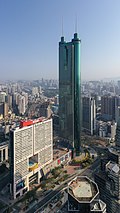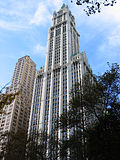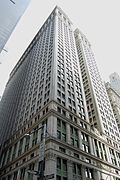Top Qs
Timeline
Chat
Perspective
List of skyscrapers by floor area
From Wikipedia, the free encyclopedia
Remove ads
This list of skyscrapers by floor area includes the largest skyscrapers in the world, measured in square meters (m2) and square feet (sq ft). To qualify as a skyscraper, a structure must be self-supporting, without relying on tension cables or external supports for stability, and must reach a minimum height of 150 meters (492 feet). Furthermore, at least 50% of its height must consist of habitable floor space.[1] Structures such as communication and observation towers—like Tokyo Skytree, the CN Tower, or the Eiffel Tower—are categorized as non-building structures and are therefore excluded from this article (see list of tallest buildings and structures).
This article needs to be updated. The reason given is: there may be entries missing from the list. Additionally, some floor areas refer solely to a skyscraper, while others include adjoining podiums or even other skyscrapers within a complex, which might cause confusion. Further revisions will be needed to clearly distinguish whether the floor area provided represents only the skyscraper or the entire complex. (December 2024) |

As of December 2024, and based on the criteria outlined above, the world's largest skyscraper by floor area is Tokyo's Azabudai Hills Mori JP Tower, with 461,774 m2 (4,970,490 sq ft) of floor area. Tokyo and New York City are the cities with the most skyscrapers included in the list, while China leads as the country with the highest number of entries overall.
Remove ads
Largest skyscrapers in the world
Summarize
Perspective
This list ranks the largest skyscrapers in the world by floor area. To be included in the list, buildings must meet the definition of a skyscraper outlined above and have a floor area of approximately 200,000 m2 (2,200,000 sq ft) or more. The "Year" column indicates the year in which a building was completed. Buildings that are still under construction but have been topped out, as well as unfinished ones, are included. Unfinished buildings are unranked.
Indicates skyscrapers that are or were once the largest in the world by floor area
Indicates skyscrapers that are still under construction but have been topped out
Indicates unfinished skyscrapers whose estimated completion year is unknown
Remove ads
Largest complexes
Summarize
Perspective
This section lists the world's largest skyscraper complexes by floor area. A skyscraper complex may consist of multiple skyscrapers, as well as other buildings or facilities, that are either physically connected to each other or part of the same development project.
The Abraj Al-Bait, Hudson Yards, and Azabudai Hills complexes are among the largest skyscraper complexes in the world by floor area.
To qualify for these lists, skyscrapers must be constructed close to each other and be part of a single complex. Significant height differences between the buildings are allowed as long as they belong to the same project. Buildings may or may not be connected via a podium or skybridges. Non-skyscraper buildings or structures can be part of the complex, and their floor area may be included in the total calculation. Single-skyscraper complexes typically include a skyscraper integrated with a shopping mall or other facilities.
Abeno Harukas (1 skyscraper), Haeundae LCT The Sharp (3 skyscrapers), and Raffles City Chongqing (8 skyscrapers).
The lists below are categorized based on the number of skyscrapers within a complex.
One skyscraper
This list includes complexes that feature only one skyscraper, providing an alternative measurement for some skyscrapers already listed in the Largest skyscrapers in the world section above. To be included, these complexes must have a total floor area of approximately 200,000 m2 (2,200,000 sq ft) or more.

Indicates skyscrapers that are still under construction but have been topped out
Two skyscrapers
This list only includes complexes that feature two skyscrapers. Other facilities may or may not be included. Twin buildings, commonly referred to as twin towers, are included. These complexes must have a total floor area of approximately 200,000 m2 (2,200,000 sq ft) or more. The "Year" column refers to the completion year of the most recently finished building in the complex.

Indicates twin skyscrapers, having the same or nearly the same height and identical characteristics/designs
Indicates skyscrapers that are still under construction but have been topped out
- ICONSIAM
- Berjaya Times Square
- JR Central Towers
- Petronas Towers
- Federation Tower
- Tokyo Metropolitan Government Complex
- Neva Towers
- Brookfield Place (Toronto)
Three skyscrapers
This list only includes complexes that feature three skyscrapers. Other facilities may or may not be included. These complexes must have a total floor area of approximately 300,000 m2 (3,200,000 sq ft) or more. The "Year" column refers to the completion year of the most recently finished building in the complex.

Indicates triplet skyscrapers, having the same or nearly the same height and/or identical characteristics/designs
Indicates skyscrapers that are still under construction but have been topped out
- JR Central Station Complex
- Landmark 72
Four skyscrapers or more
This list includes complexes that feature four or more skyscrapers. Other facilities may or may not be included. These complexes must have a total floor area of approximately 500,000 m2 (5,400,000 sq ft) or more. The "Height" column refers to the height of the tallest building within the complex, which may or may not be the largest one. The "Year" column refers to the completion year of the most recently finished building in the complex.

Indicates skyscrapers that are still under construction but have been topped out
- Renaissance Center
Remove ads
Largest under construction and proposed
Summarize
Perspective
The tables below list skyscrapers currently under construction and proposed for construction, with floor areas expected to reach approximately 250,000 m2 (2,700,000 sq ft) or more. Visionary projects are excluded.
Under construction
Indicates skyscrapers that are still under construction but have been topped out
Proposed
Remove ads
Timeline of largest skyscrapers in the world
Summarize
Perspective
This is a list of buildings that once held the title of largest skyscraper in the world by floor area. The Empire State Building and the original World Trade Center Twin Towers each held this distinction for nearly 30 years. Currently, the title belongs to Azabudai Hills Mori JP Tower.
Indicates skyscrapers that have been demolished or destroyed
Remove ads
References
Wikiwand - on
Seamless Wikipedia browsing. On steroids.
Remove ads



















































































































